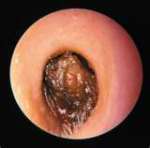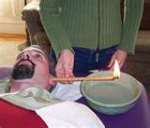Seriously, Does This Look Like a Good Idea?! (The Audiologist, anonymous)
Audiologists spend a good deal of time talking to patients and the public about ear protection, often via use of Hearing Protection Devices (HDPs). Today’s posts picks up the protection theme, but this time it’s all about ear wax and the weird ways people adopt to remove it from their ears.
Audiologists and Consumers: Please read on and send in your thoughts via the Comment section.
What is Earwax and Why Do We Have It?
Earwax (cerumen) is secreted by glands in the skin of our ear canals. It’s a helpful and natural part of your body’s defenses. Cerumen protects your ear canal by trapping dirt and debris. It also slows the growth of bacteria in the ear. Earwax normally works its way out of the ear canal on its own. Then, it’s washed away or falls out as new wax is secreted to replace it.

Impacted Cerumen in Human Ear Canal
We don’t know why some people secrete more cerumen than others. We also don’t know why some people experience earwax blockage or why earwax blockage sometimes occurs in only one of their ears.
This much we do know: If you have symptoms of ear pain, itchiness, or hearing loss it may be due to excessive earwax, but it may be due to another cause that should be medically treated. It is nearly impossible to look in your own ear. But Audiologists do it all day long, using special “otoscopes” with halogen lighting. To find out if you have excessive wax buildup, just ask your audiologist or physician to look in your ear with an otoscope. (Do not ask your local ear candler.)
What is Ear Candling?
Patients sometimes ask The Audiologist about ear candling. What is it? Does it work? Is it safe? Ear candling, also called ear coning or thermal-auricular therapy, is an alternative medicine practice claimed to assist the natural clearing of earwax from a person’s ear. It’s done by lighting one end of a hollow candle and placing the other end in the ear canal. In theory, the heat from the flame creates a vacuum seal and the earwax adheres to the candle.
“During the course of investigating ear candling we often encountered the belief that ear candles create a vacuum that draws fluids and wax from the ear canal, which in turn produces beneficial health effects. To investigate this notion, we obtained several ear candles from a local health food store and investigated their properties….. CONCLUSIONS: The ear candle, when burned, produced a brown waxy substance that looks like ear wax. However, since the wax appears whether or not the candle is placed in a human ear, we conclude that the source of the wax is the candle and not the ear. It is possible that the candle produced wax but also extracted solid material from the ear was mixed with the candle wax. However, since the candle remnant of the control candle and the one inserted into a human volunteer weighed exactly the same, we conclude that this did not happen. The human subject reported no feeling of a vacuum which is purported to occur during the burning of the candle. The control candle produced smoke that poured from the bottom of the tapered end, suggesting that positive, not negative pressure was being produced. The subject reported no subjective feelings invoked by the treatment, suggesting that the ear candle was ineffective in a controlled environment.” (Jeffries, W., et al.)
For a hair-raising discussion of the history, claims, and disasters associated with ear candling, please click on this article at QuackWatch. It’s an informative and entertaining read.
Conclusions and Recommendations
 It seems safe to conclude that ear candling doesn’t work and may result in injuries (i.e., burns, ear canal obstructions, ear drum perforations).
It seems safe to conclude that ear candling doesn’t work and may result in injuries (i.e., burns, ear canal obstructions, ear drum perforations).
When it comes to recommendations, The Audiologist sings an old, but true, refrain: If earwax, or any other ear/hearing issue, becomes a problem, audiologists are your first course of action. Most are trained in cerumen removal and will take simple steps to remove the wax safely. Just as important, they will design a plan of action to keep your ear wax under control. This is especially important for those who wear hearing aids and need to keep them working in spite of wax build up.
There’s nothing more dangerous than Wild Wax and none better to tame it than your Audiologist! (The Audiologist, anon)
Footnotes and References
- The original study by Jeffries W et al is no longer accessible in full on the Internet.
- Schenk H Dancer J. Ear Candling: Conflicting Information, Confused Consumers. Audiology Online, Feb 13, 2006.
Images cocurtesy of Bing and wild wax combo






